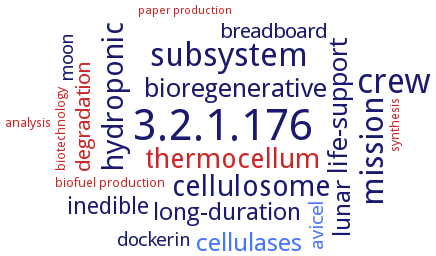3.2.1.176: cellulose 1,4-beta-cellobiosidase (reducing end)
This is an abbreviated version!
For detailed information about cellulose 1,4-beta-cellobiosidase (reducing end), go to the full flat file.

Word Map on EC 3.2.1.176 
-
3.2.1.176
-
crew
-
subsystem
-
mission
-
hydroponic
-
cellulosome
-
thermocellum
-
bioregenerative
-
life-support
-
cellulases
-
lunar
-
long-duration
-
inedible
-
degradation
-
breadboard
-
avicel
-
dockerin
-
moon
-
synthesis
-
biotechnology
-
biofuel production
-
analysis
-
paper production
- 3.2.1.176
-
crew
-
subsystem
-
mission
-
hydroponic
- cellulosome
- thermocellum
-
bioregenerative
-
life-support
- cellulases
-
lunar
-
long-duration
-
inedible
- degradation
-
breadboard
- avicel
-
dockerin
-
moon
- synthesis
- biotechnology
- biofuel production
- analysis
- paper production
Reaction
2 cellohexaose
+
2 H2O
=
2 cellotriose
+
Synonyms
1,4-beta-D-glucan cellobiohydrolase I, 1,4-beta-D-glucan-cellobiohydrolase I, CBH, CBH I, CBH Ib, CBH-1, CBH1, CBH2, Cbh3, Cbh7B, CbhA, CBHI, CbhI.1, Cel48A, Cel48C, Cel48S, Cel48S cellulase, Cel48Y cellulase, Cel6A, Cel7A, Cel7B, Cel7D, Cel9B, cellobiohydrolase, cellobiohydrolase 1, cellobiohydrolase A, cellobiohydrolase CelS, cellobiohydrolase class I, cellobiohydrolase I, cellobiohydrolase I-I, cellobiohydrolase I-II, cellobiohydrolase II, cellobiohydrolase II-I, Celluclast, Cellulase SS, CelO, celS, CelSS, CelY, Ct-Cel5F, DDB0202233, DICPUDRAFT_151874, EG I, EgxS, endoglucanase, endoglucanase SS, exo-1,4-beta-glucanase, exo-acting cellulase, exo-beta-1,4-glucanase, exocellulase, exocellulase E4, exocellulase E6, exoglucanase, exoglucanase S, exoglucanase-1, GH7 CBH, More, reducing end acting processive exocellulase, reducing end-acting CBH, Tfu_1959, ThCel7A, THITE_62596, Tr-Cel7A


 results (
results ( results (
results ( top
top






